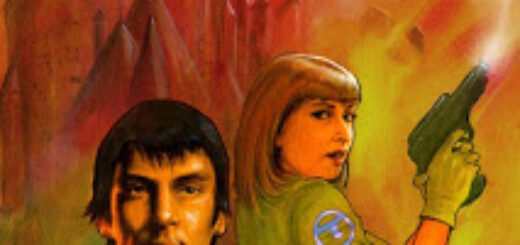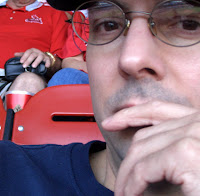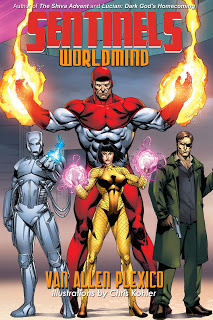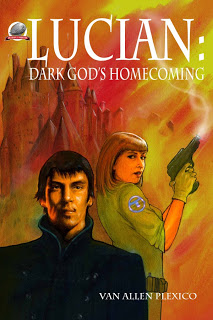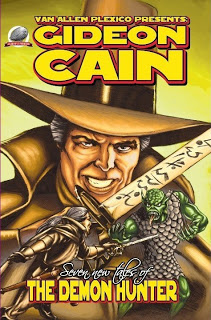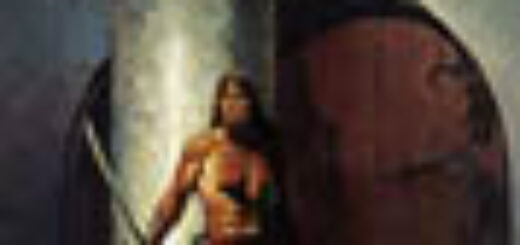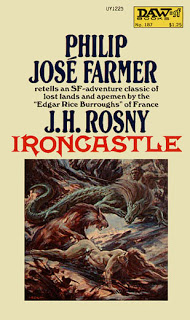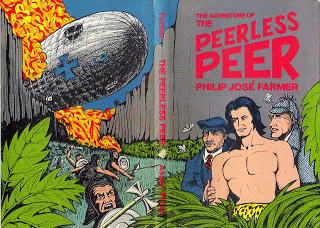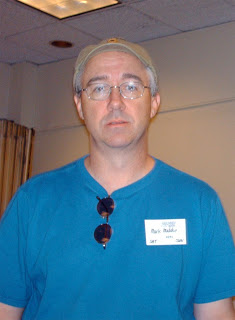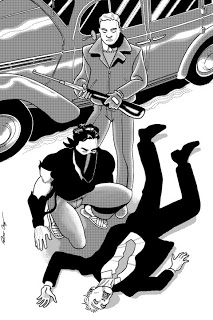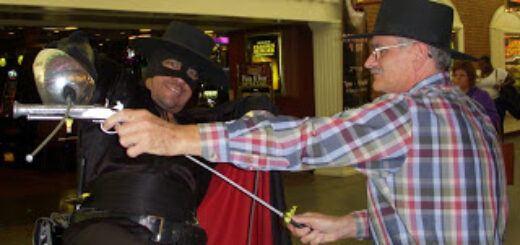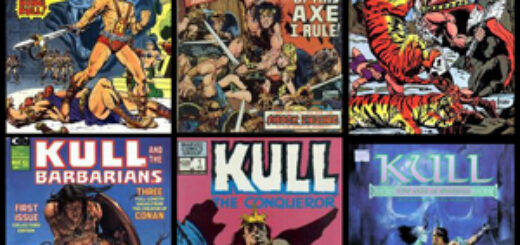Tagged: Thor
SIX DEGRESS OF PJF BY WSE!!!
Win Scott Eckert © 2005-2010
Farmerphile no.2
Christopher Paul Carey and Paul Spiteri, eds., Michael Croteau, publisher, October 2005
“Six Degrees of Philip José Farmer”
By Win Scott Eckert
Last column we discussed the great genealogist Philip José Farmer’s discovery of the “Wold Newton Family,” – highly influential people, many heroic, and some villainous, whose lives are chronicled in the guise of popular literature. While Farmer wrote critical essays and serious biographies in which he revealed his researches, he was also not above divulging more of his findings under the guise of popular fiction.
A full survey of Farmer’s Wold Newton “fiction” is beyond the scope of this column, so I will focus here on a few key pieces which reveal that, beyond the Wold Newton Family (WNF) proper, there is indeed a whole “Wold Newton Universe” (WNU) ripe for exploration. In fact, if one follows the trail of connections through his fiction, one is lead to the most astonishing places.
For instance, after reading Tarzan Alive and Doc Savage: His Apocalyptic Life, one might not be surprised to find in Farmer’s novel The Adventure of the Peerless Peer that Tarzan, Sherlock Holmes, Mycroft Holmes, The Shadow (“Colonel Kentov”), and G-8 (“Wentworth”) shared an adventure together. One might not even be surprised that three other WNF members are mentioned: Leftenant John “Korak” Drummond, Lord John Roxton, and Allan Quatermain. But one might be taken aback to also see Dr. Gideon Fell and Henry Merrivale, two renowned detectives whose cases were recounted by John Dickson Carr. Farmer never mentioned them as Family members, but surely their appearance is indicative that sleuths in the larger WNU are not limited to WNF members.
Farmer also wrote two novels of pre-history, Hadon of Ancient Opar and Flight to Opar. In these, he discovered connections between the lost city of Opar from Burroughs’ Tarzan novels, and the novels of H. Rider Haggard. In a later interview, Farmer revealed that Hadon’s son emigrated south and founded the city of Kôr, from Haggard’s She. He carried with him a huge axe made of meteorite iron, which was eventually passed down to Umslopogass, the great Zulu warrior, who shattered it in the city of Zu-Vendis (Haggard’s Allan Quatermain). In this way, Farmer revealed that the WNU has a rich history beyond the WNF.
In Farmer’s translation of J. H. Rosny’s Ironcastle, he adds references to several WNF members, including Phileas Fogg, Sherlock Holmes (through a reference to the Diogenes Club from the Holmes stories), Joseph Jorkens, Doc Savage (although the reference in Ironcastle is really to Doc’s father, Dr. Clark Savage, Sr.1), and Professor Challenger (through a reference to the South American expedition from Doyle’s The Lost World). Sir George Curtis also appears; he is the nephew of Sir Henry Curtis from H. Rider Haggard’s Allan Quatermain novels. Farmer states that Hareton Ironcastle is related to Professor Porter, Jane’s father from the Tarzan books.
An interesting new element that Farmer adds with this crossover is the Baltimore Gun Club. This means that some version of Jules Verne’s novels, From the Earth to the Moon and The Purchase of the North Pole (aka Topsy Turvy), take place in the WNU. Since Verne’s works are also interconnected, this means that other Verne novels such as Hector Servadac, The Adventures of Captain Hatteras, and The School for Robinsons (aka The School for Crusoes) occur within Wold Newton continuity.
Farmer’s novel of young Doc Savage’s first adventure, Escape from Loki, added many other elements to the WNU, as seen from this excerpt from my Wold Newton Universe Crossover Chronology:
ESCAPE FROM LOKI
Clark “Doc” Savage, Jr., meets his friends and associates Ham Brooks, Monk Mayfair, Renny Renwick, Long Tom Roberts and Johnny Littlejohn in the German prison camp Loki. There is mention of a “worm unknown to science,” which can be demonstrated to be a direct link to the Cthulhu Mythos. Doc’s tutor in mountain climbing, yoga, and self-defense, Dekka Lan Shan, is the grandfather of Peter the Brazen. A character named Benedict Murdstone also appears. Savage & Co. meet Abraham Cohen, who would go on to membership in Jimmie Cordies’ band of mercenaries, and an Allied prisoner named O’Brien, a soldier of Irish extraction. It is also mentioned that Doc Savage was trained by an aborigine, Writjitandel of the Wantella tribe. And Doc’s Persian Sufi tutor is named Hajji Abdu el-Yezdi.
Escape from Loki is a novel by Philip José Farmer, Bantam Books, 1991. The “worm unknown to science” was first referred to in Watson’s / Doyle’s “The Problem of Thor Bridge,” and was followed-up on in Harry “Bunny” Manders’ Raffles tale (edited by Philip José Farmer), “The Problem of the Sore Bridge – Among Others.” Peter the Brazen, aka Peter Moore, was an adventurer in pulp stories written by George Worts. Of Peter the Brazen, Wold Newton scholar Rick Lai adds, “One of Worts’ Gillian Hazeltine stories mentions a ship, The King of Asia, which also appears in the Peter the Brazen stories. Worts’ Singapore Sammy story, “South of Sulu,” mentions that Sammy was friendly with a jewel trader, De Sylva. This may be the same character as the jewel merchant, Dan de Sylva, who appears in a later Peter the Brazen story, “The Octopus of Hongkong.”
Murdstone is related to the family which appears in Charles Dickens’ David Copperfield. The Jimmie Cordie adventures by William Wirt are a series of twentyone stories about a group of mercenaries in the Far East after the Great War. Rick Lai adds: “O’Brien is probably Jem O’Brien, ex-jockey, exconvict, decorated soldier in the American army during World War I, and special assistant to the Scarlet Fox. Created by Eustace Hale Ball, the Scarlet Fox was a pulp hero who appeared in seven stories in Black Mask during 1923-24. The first six stories were published as a novel, The Scarlet Fox, in 1927.”
In Arthur Upfield’s novel about the Australian detective, Inspector Napoleon “Bony” Bonaparte, No Footprints in the Bush (1940), a major character is Writjitandil (Farmer changed an “i” to an “e”) of the Wantella tribe. Rick Lai writes again: “In an introduction to an edition of an Upfield novel which does not feature Bonaparte, The House of Cain (Dennis McMillan, 1983), Philip José Farmer speculated that Bonaparte was the illegitimate son of E. W. Hornung’s A.J. Raffles. In Upfield’s novels, Bonaparte is illegitimate son of an unnamed white man and an aborigine woman. Upfield’s early novels suggest that Bonaparte was born in the late 1880s. Raffles was in Australia about that time according to Hornung’s ‘Le Premier Pas.’”
Chris Carey points out that “Sir Richard Francis Burton (the real-life protagonist of Farmer’s Riverworld series) wrote a curious book entitled The Kasîdah of Hâjî Abdû El-Yezdî. At the time the volume was first published, Burton claimed to be merely the translator of the wise Sufi’s work. However, the truth finally came out that Burton wrote it. While Haji Abdu El-Yezdi may be a fictional character in our world, we may only assume that he existed in flesh and blood in Farmer’s Wold Newton Universe.”
One never knows when additional information from Farmer’s researches will come to light. His tale “After King Kong Fell” clearly takes place in the WNU because WNF members Doc Savage and The Shadow arrive on the scene in the aftermath of the giant ape’s plummet from Doc’s headquarters, the Empire State Building. That King Kong exists in the WNU may be old news to some.
Additional Sources:
Carey, Christopher Paul. “Farmer’s Escape from Loki: A Closer Look.” The Official Philip José Farmer Home Page. <http://www.pjfarmer.com/fan/chris1.htm>.
Pringle, David. “Allan and the Ice Gods.” Violet Books: Antiquarian Supernatural, Fantasy, and Mysterious Literatures. <http://www.violetbooks.com/haggard-pringle.html>.
1 To be perfectly accurate, the real name of Doc Savage’s father, as Farmer demonstrated in Tarzan Alive and Doc Savage: His Apocalyptic Life, is Dr. James Clarke Wildman, Sr.
‘Thor’ trailer launches

And here we go…
We have lots of stuff from the preview at San Diego this year, and a lot of new material as well. Looking good– what do you think about it?
MOONSTONE MONDAY-NOTED PULP ARTIST MARK MADDOX INTERVIEW!
AP – Hi Mark, and thanks so much for stopping by All Pulp HQ. In the past few years you’ve made quite a name for yourself in the pulp field and it is a pleasure to finally be able to sit and talk with you about your art career. Why don’t we start with a little informal background. Where were you born and raised? Where do you live now? And do you have a “day” job with doing pulp art?
MM – I was born on Tyndall Air Force Base in Panama City, Florida to Don and Joann Maddox. I have one brother, Mike and three sisters, Elise, Carole and Jeanne . Being a military brat had us moving around a lot. We lived in Germany, South Dakota, Maryland and North Carolina. After my dad retired we moved to Tallahassee, Florida. Later, when I got married my wife Carlyn and I moved to Thomasville, Georgia, had two incredible kids and are now settled in Athens, about an hour east of Atlanta. We really like it here.
At present the only work I am doing is freelance… the fun kind: Book covers (some which are pulp), illustrations, comic book covers, monster magazine covers, private commissions, game design, concept designs, logos, etc. It isn’t at the financial level I would like yet but I’m fairly new to this type work. Before that I did straight corporate graphics which isn’t terrible but it’s not nearly as much fun as my current endeavors.
AP – Mark, what kind of art education do you have? Did you always want to be a professional artist or was it something that came to you later in life?
MM – My parents were very supportive of my abilities which started around the age of ten. In high school I took art classes but the teacher was a joke. Some of the interns that came in were a lot more beneficial to my creative advancement. My dad saw my talent as a possible life long career and pushed me to go to take the commercial art course at Lively Vo-Tech school in Tallahassee. I had a great teacher by the name of Oral Ledbetter. He was an old school commercial artist/ illustrator and he taught us things that are all but lost today with computers and such. I also went to the local community college and Florida State University which had good art programs.
AP – Were you a comic book or sci-fi fan growing up? And did either of these genres influence your taste in art?
MM – Comics, movies, monster magazines, television…I ate it all up. My particular favorite reads were Jules Verne, H.G. Wells, Doc Savage reprints, Edgar Rice Burroughs sci-fi, etc. Comics included Fantastic Four, Stan Lee and Jack Kirby Monster comics, Thor, Hulk, Captain America. Chester Gould’s Dick Tracy is easily my favorite comic strip. I’m actually one of those fans who likes Dick Tracy during his sci-fi period.
AP – Which artists, past and present, do you admire and did their styles have an effect on your own work as it developed?
MM – Dr. Seuss was awesome for a little kid. To this day I look at his work when I’m reading to my kids and marvel at it. Jack Kirby is, to me, far and away the greatest comic book artist. I am also a big fan of Will Eisner, Moebius, Frank Bellamy, Sergio Toppi, Joe Kubert, John Severin, Herge, Jose Gonzlez, Geoff Darrow, artists on the Jonny Quest TV show and so many more. I am a huge fan of illustrators like N. C. Wyeth, Dean Cornwell, Virgil Finlay, Franklin Booth, James Montgomery Flagg, Charles Dana Gibson, Basil Gogos, Sanjulian, etc. Fine artists include the impressionists, John Singer Sargent, Anders Zorn, Vermeer, Edward Hopper, Chuck Close and the Photorealists,
AP – Much of your early work is clearly inspired by horror and sci-fi movies. I take it you a movie fan? What is your favorite movie of all time?
MM – That’s not a fair question! I have so many favorites it’s impossible to pick just one. Lawrence of Arabia and Doctor Zhivago are two of my classic favorites. Raiders of the Lost Ark, Aliens and Universal monster movies are some of my genre favorites. Popcorn munchers include: Dracula A.D. 1972, Japanese monster movies, Omega Man, Hell Drivers. The list is so huge a ten gig hard drive couldn’t hold it.
AP – Okay, so how did you get involved with pulps?
MM – A guy named Blake Wilkie introduced me to Ron Fortier who was with Wildcat books at the time. We did a few tiny comic projects together and one day he dropped me a line saying he needed a cover for his book Captain Hazzard and the Curse of the Red Maggot. I think the artist that was to do it had to drop out at the last second. It was a dream come true for me. He needed it quick and I was willing to burn the midnight oil to get it ready.
AP – You seem to have a natural affinity for pulps. What is it about the genre that appeals to you?
MM – I was born in the early sixties and came back to the United States when the big thing was the campy batman TV show (I preferred The Green Hornet). I later found out about pulps, radio plays and cliffhanger serials (Tom Tyler as Captain Marvel, yay!) and realized there was a huge amount of this great entertainment from a long time ago where fantastic adventures were treated seriously. Doc Savage, The Shadow, John Carter, Weird Tales, etc. That’s just great stuff! Plus it fit right in with my love of comics and old Hollywood.
AP – You were the recipient of the first Pulp Factory Award for Best Pulp Cover of 2009.
Tell us about that and how it all came about? What piece did you win it for?
MM – The piece I won for was Airship27’s Sherlock Holmes: Consulting Detective. It was actually a piece that I resisted doing. I am a big fan of Holmes but in his original Strand Magazine form. When I was told I could do the art and design based on the original look and typography I was all for it. I was also allowed to dedicate the book to my late mother-in-law. She was a big Holmes fan and it would have pleased her so. I was very happy with the way that piece turned out because it was my take on Holmes and Watson the way they look in my mind’s eye. Most people don’t realize that Watson was a handsome, fit man.
AP – Weren’t you actually nominated for two covers that year and how did it feel to compete against yourself? Did you prefer one piece over the other?
MM – It felt great and strange! I was hoping they didn’t cancel each other out. The other cover was Captain Hazzard and the Python Men of the Lost City. And I really like them both equally. That’s a good feeling to have.
AP – Since your work for Airship 27, you’ve expanded your pulp career by working for other companies in the field. Tell us about your projects for Bill Cunningham’s Pulp 2.0 Press?
MM – I heard that Bill was going to be reprinting Don Glut’s Frankenstein books he had written in the sixties. Frankenstein is one of my all time favorite subjects and I had been reading Don Glut’s work since I was ten and I had been looking for those books for a long time. I wrote Bill and begged him to consider me for the covers.
I’ve completed the first cover in the series called Frankenstein Returns! I am very pleased with the way it turned out and Bills graphics look great on it. I’m getting ready to start volume two’s cover in the next month or so. I’m pretty excited about it.
AP – You also contributed covers to Win Scott Eckert’s CROSSOVER books, right?
MM – Yes, there are two of those so far and it was a lot of fun featuring all these classic characters together in the same image.
AP – You recently started doing covers for Moonstone Comics. Tells us about that and did the experience vary much from doing pulp covers?
MM – I’ve completed two covers and am working on a third. The first one was for Kolchak: The Night Stalker Files written by Christopher Mills . I was in front of the TV the night The Night Stalker film premiered in the early seventies and have been a fan ever since. It was another dream come true. The second cover was for the first issue of The Heap written by Charles Knauf (Iron Man and Captain America: Theater of War), featuring the creature from the Airboy comics of the forties. What could be better than a monster tearing the heads off of Nazis? The latest cover is for the great superspy Derrick Flint written by Gary Phillips (Vertigo Crime’s COWBOYS). I’m doing this piece with a nod to sixities design styles and having a blast. Moonstone publisher, Joe Gentile has been really great to work with.
AP – People who have met you personally all comment on your dry, acerbic wit. Have you always had this humorist bent and do you like looking at the world in a slightly skewered way?
MM – I don’t know. I come from a family smart mouths. Everything had to have a comeback. It’s a way for me to keep things lively and it’s nice to see people laugh.
AP – Is there any single genre you have yet to work in that you would really like tackle?
MM – Adventure, 60’s period Marvel heroes, monsters, drama, crime, sci-fi. I’d even like to tackle a western some time. In the seventies, Thrilling Adventures Magazine did a short comic about Lawrence of Arabia. I would love to work on something like that. A sort of adding on to the legend. Like the Daniel Boone TV show.
AP – So, wrapping this all up here. What’s on the horizon for you project wise? Can you give our readers some preview as to where your marvelous art is going to pop up next?
MM – Well besides the work for Moonstone I’ve got two new Hammer film books that are coming out. One called The Last Bus to Bray: The Unfilmed Hammer. It’s about many of the films that Hammer almost got produced but didn’t see the light of a projector for one reason or another. This includes the infamous Vampirella, a movie about Prince Vlad starring Yul Brunner, another about the Loch Ness Monster with backing by David Frost and many others. The other book is from Hemlock called Hammers Fantasy & Sci-Fi dealing with films outside of the Dracula and Frankenstein realm (One Million Years B.C., Quatermass, etc.). There are also one or two projects I’ve been sworn to secrecy on although I can say they are sci-fi and monster related… plus more artwork for Little Shoppe of Horrors.
AP – Mark, this has been a blast. Thanks so much.
MM – Thank you.
PULP ARTISTS’ WEEKEND-PEDRO CRUZ SPOTLIGHTED! INTERVIEW AND GALLERY!!!
AP – Hi Pedro, and thank you so much for agreed to doing this little interview with here at All Pulp. Let’s get started with a little background about yourself. Tell us something about who Pedro Cruz is. Where do you live, where did you grow up etc.etc. and what is your current status?
PC – Hi, thanks for having me. I live with my dear wife on the same town where we’ve lived since we were kids, a small suburb of Lisbon, the city where we were born, in Portugal. Thirty-five years ago (that’s how old I am) Portugal had just left a long dictatorship and, by modern standards, it was an incredibly old fashioned place! Just to give you an idea, when I was born, there was only one single TV channel (owned by the state) broadcasting in black and white for just about six hours every evening! Everybody saw the same shows and heard the same news – it was like growing up on a little village. We used to watch old Warner Bros. and Hanna-Barbera cartoons, Japanese animated series like Marco, Heidi, Future Boy Conan, experimental animation films from Canada and even from the old eastern bloc countries too, but also old ‘60s series like The Avengers, The Twilight Zone or The Outer Limits. There were many documentaries and we got to see old classic Hollywood and European movies in prime-time, something that would never happen now. Plus, most shows, even for kids, were broadcast in their original languages and subtitled, which made it easier for the kids of my generation to become polyglots and actually helped us learn to read. So TV had a huge part on shaping up my worldview. At the same time, there were plenty of newsagents with loads of comics featuring the Phantom, Mandrake, Flash Gordon, Prince Valiant, Popeye, Uncle Scrooge, Donald Duck, Mickey Mouse, Little Lulu, Tubby, Richie Rich, Casper, Hot Stuff, Turma da Monica, Superman, Batman, Spider-Man, Captain America, the Incredible Hulk, Conan… just to give you an idea, they could have a whole wall devoted just to comics. These were mostly Brazilian editions, as Brazil is an old colony of Portugal and we share the same language. I should point out that in terms of format, these were usually quite different from traditional American comics, about A5 in size ( 210 x 148 mm or 8.3 x 5.8 in ) and had from 64 to 300 pages featuring both current tales and reprints of old golden or silver age stories. And they were very cheap – I could read all the marvel line easily as one single magazine would be a sort of anthology consisting of one or two issues of the original editions of Captain America, the Avengers and Thor, for instances. Sometimes, they also featured articles on the authors or had pastimes or bring some kind of toy or poster… They were fun! On proper bookstores you had B.D. (Bande-Dessinée) hardcover comic albums with Tintin, Astérix, Spirou, Smurfs, Lucky Luke, Blake & Mortimer, Michel Vaillant, Ric Hochet, Valerian, Lieutenant Blueberry, Corto Maltese, Mafalda… I don’t want to sound like a grumpy old man, but nowadays, this reality I’m describing is mostly gone. Bookstores still have B.D. albums, but it’s very rare that you find newsagents carrying comics and there are very few anyway. Back to the past, my parents were very supportive and enthusiastic of me, they were big moviegoers and took me to see the Disney, Spielberg and Lucas movies that have had such a big impact on me and my generation. I was incredibly lucky of being born in the right time and place to experience this pop golden age and it left a mark in me that made me want to make things like what I saw in movies, cartoons and comics. I was an only child and my dad would bring home paper, pencils and pens in ample supply, so I’d spend long hours trying to draw characters and adventures either copied or imagined, in a style that echoed that same sensibility and aesthetic of all this pop culture. Later I went to study architecture in college, that seemed like a nice choice because I had the grades needed to get in there, it was a respectable profession and I still got to draw and learn art, but my heart was never there. During college, I worked for awhile at a small animation studio and it was an eye opener to how that really functioned. It was the galleys, really, you were just a cog in a machine. Animators got treated with very little respect and earned minimum wages. I left that, finished my graduation and went on to become a teacher while never stopping to draw. I won two awards on the annual public cartoon contest at Amadora Cartoon (the biggest comic convention here) and had quite a few illustrations, comics and cartoons published on DNJovem, a youth supplement that used to be a part of the print edition of Diário de Notícias, one of our leading newspapers. Unfortunately, there is no comics industry here in Portugal so I developed my blog as a way of showing my work. Currently, besides the comics on the blog, I’m also producing illustrations for Airship27.
AP –What level of formal art education did you have? What schools did you attend? Do you also teach art? If so, what kind?
PC – I graduated as an architect by the Faculdade de Arquitectura da Universidade Técnica de Lisboa and this year I’m taking a master’s degree on the area of Education, specifically Art Education. Currently, I work as a teacher on the public school giving art lessons to the 5th and 6th grades. My students are mostly children of African and gypsy ethnics from one of the most socially problematic suburbs in Lisbon, they’re extraordinarily creative and love expressing themselves through the arts which makes my job very fulfilling and fun too. I’m also coordinating a couple of projects at my school, one involving a role-playing game that helps pupils develop personal and social skills through problem-based learning, and another where I’m tutoring a small group of students developing a comic book and learning the different tasks involved in its creation (writing, penciling, inking, coloring, lettering).
AP –Did you always want to be a commercial illustrator? What was your first professional commission? Have you ever done work in the advertising field?
PC – I’ve always wanted to work on areas related to art, and had dreams of being able to draw as a full-time job. Unfortunately, the market here in my small country is diminutive and doesn’t pay all that well, especially if you want to have a house and family. The first time I got a professional commission was right after college, when an old classmate’s girlfriend asked for a caricature of all her fellow employees and her boss to give him as a good-bye present because he was moving to another department.
AP –Your website indicates you’ve done comic work. Have you always been a comic book fan and what are some of the comic projects you have worked on?
PC – I have always been an avid comic book fan and it’s only been on recent years that my consumption of comics has slowed down almost to a halt. I still read a book here and there but it has to be done either by a friend or from a very limited list of artists whose work I continue to follow. In spite of that, I still find great enjoyment in creating and drawing comics.
As far as collaborations in comics go, I worked on Guard Dogs, a series written by Jason Quinn for Starscape Illustrated, a UK-based fanzine. I drew “Helljacket”, a short story written by Steve Zegers for Ronin Studio’s Ronin Illustrated. I also drew the first issue of NiteLite Theatre’s White Ghost and a short story featuring the Semite, one of writer Mike Haselhoff’s characters. There’s also been Grace, a great short story written by Aria Ponto. My blog is the best place to find some of these and other comics, if you take the time to explore it.
I’ve done entirely on my own WHYM and METANOIA. At the moment, the later is still a work in progress which I post once a week on my blog but it has a definite ending. I also have a few more projects in different stages of development which will hopefully see the light of day sooner or later.
AP –What graphic illustrators have been the most influence on your development?
What did you learn being a fan of their work?
PC – Comic book art has always been my primary influence and the list of graphic illustrators who have and continue to influence my development would probably be too long to relay here. Speaking strictly for the pulp illustrations I’ve been doing for Airship 27, I’ve purposefully tried to do what I’d call a classic American style. To this end I’ve been using the duoshade technique, which I was first introduced to by the work of John Byrne in the early 1990s in comics such as his OMAC mini-series and Namor. Originally, this was done through the use of a special paper called craftint, I think, that had imprinted lines or dot screens in non-repro blue, that became visible when a special chemical was applied. I was fascinated with the results of such technique and thought it was a very efficient and graphic way of introducing value, tone and special effects that could enhance the sense of mood, place, texture and dimension in a drawing while still working with just pure black ink on white paper. I investigated more and learned that the original master of such technique in comic illustration was the late great cartoonist Roy Crane and have devoured his work whenever I’ve come across a reprint of his comic strips. Since I had no access to craftint boards or the chemicals used to develop that process, I ended up creating duoshade through digital effects on the computer. So, basically, those are the two cartoonists that have probably influenced most the work I’ve been doing for the pulps.
AP –Of all the artists in the field today, which do you admire the most and why?
PC – I am very omnivorous in my tastes but, speaking strictly of comics, of all the artists still regularly working professionally in the field, the one that still amazes me the most is Jean Giraud “Moebius”. I can look repeatedly even at his latest works, like Inside Moebius or Le Chasseur Déprime, and still feel surprised, inspired and refreshed. Looking at his work makes me want to draw! There’s no bigger compliment I can think of for an artist.
AP –How did you first become affiliated with Airship 27 Productions? Was this the first pulp illustrating you had ever done?
PC – My friend writer Aaron Smith came up with a story featuring Doctor Watson and Doctor Seward for a possible graphic novel for me to illustrate. Then he started to work for Airship27 and pitched the same idea as a novel to Ron Fortier, presenting the possibility of me working as an illustrator for the novel. Ron liked my art and asked if I was also interested in contributing illustrations for Jim Anthony Super-Detective, another of their series. Naturally, I jumped at the chance of illustrating pulp adventures. After all, many of the comic book heroes which I’d enjoyed so much as a kid had their roots on the pulps. I’d never done it before, but I’ve loved the experience so far. Ron Fortier and Rob Davis have been incredibly easy and friendly to work with. Their role as mentors behind this project can’t be over-emphasized and I hope our collaboration continue for many years to come.
AP – You’ve illustrated a Doctor Watson book and two featuring pulp hero Jim Anthony. Do you prefer one character over the other and do you have a different approach when doing the art for these two diverse characters?
PC – I like them both for different reasons. As far as the drawing goes, Jim Anthony comes easier because he’s just such an archetype, with his muscled physique, the strong jaw line and the defying attitude, so there’s really no way I could miss him other than on purpose. Doctor Watson, on the other hand, is much more of a challenge because not only is he closer to one of us common mortals, everybody knows him, which makes it intimidating. Drawing him is like sketching an impression of an old friend from back when you were a kid… only he is very famous, so you better make sure you draw him correctly!
AP –Is there a particular pulp or comic book character you would like to work on?
Why those characters?
PC – There’s a bunch of comic book characters I’d like to work on. Problem is they no longer have much character in them; they’re just properties. So, while I don’t rule out the possibility of working on pre-existing comic book characters – never say never – at this point in time, on that level, I’m much more interested in developing my own worlds, characters and stories, even if they are inspired by what came before. Which is basically the advice Jack Kirby gave young, new creators: if you want to follow on his footsteps, do your own thing. As far as pulp go, I think things are different as the characters I’ve been drawing for Airship 27 fall within public domain and aren’t owned by any one particular corporation whose sole intent is exploiting them and the authors involved for maximum profit at the least expense, with little care or regard for the original vision of the characters or their creators. With Airship27, there is a desire of respecting the characters and their original authors’ intentions as much as possible and everybody retains full rights to their own work, which is nicer. Beyond that, I’d like to have the opportunity of spreading my horizons and work on other genres like science-fiction and high fantasy.
AP –Here’s a tricky one. Of all the work you’ve ever done, which are you the most proud of?
PC – Oh, I won’t fall for that one, that’s like picking a favorite out of your sons. They all have their charming qualities and their faults too. Usually, the next project, the one that’s still floating in my mind’s eye, not yet materialized, that’s the one that excites me the most.
AP – Finally, is there anything you would like to plug here? Some project you want to let your fans know is coming soon? Feel free to promote away.
PC – I have my own blog www.pedro-cruz.blogspot.com where I regularly post. Again, as with drawing and making comics it is a way of communicating, of reaching out to people through my posts. Sometimes, it’s a funny video I come across on youtube, other times it’s just some rambling I have to put off my chest, often it’ll be some sketch or a comic. Currently, I’m serializing METANOIA, an experimental wordless comic, quite different from my pulp illustrations, in which I get to work with color. Once that’s finished I’ll probably take some months off to make the switch to producing fully digital artwork. For the last few years I’ve been using hybrid methods of creating art, but now it’s time to make the definitive change hoping it’ll improve my productivity while helping save some trees. If all goes well, you should all be seeing the results of that sometime in 2011. In the meantime, in terms of pulp fiction, I’m currently illustrating a new book featuring a couple of stories with Dr. Watson and Hound Dog Harker, and also a comic short story with none other than Jim Anthony Super-Detective.
AP – Thanks so much, Pedro. This has been most informative. Continued success in all your future endeavors.
PC – My pleasure.
FEATURED ARTIST-PEDRO CRUZ
INTERVIEW WITH WRITER ROBERT KENNEDY!!!
 |
| Zorro bested by Robert Kennedy! |
Iron Man 3 Cometh!
 So, what are you planning on doing May 3, 2013? On or about that day, unless I’ve gone to a preview, I’ll probably be seeing Iron Man 3.
So, what are you planning on doing May 3, 2013? On or about that day, unless I’ve gone to a preview, I’ll probably be seeing Iron Man 3.
If that seems like a long time, it’s only a year (almost to the day) after Iron Man and Tony Stark appear in The Avengers movie.
Amusingly, Disney will be distributing both movies. Whereas they own Marvel, the distribution rights on these projects is still in Paramount’s hands so, according to Box Office Mojo, Disney is coughing up at least $115 million to assume the privilege. It wasn’t too long ago that you could buy all of Marvel for that kind of money. Paramount maintains distribution rights to this year’s Thor and Captain America: The First Avenger.
No word about cast and villains, although Robert Downey Jr. is contractually expected to repeat in the lead.
‘The Avengers: Earth’s Mightiest Heroes’ has an October 20 Debut
 The Avengers: Earth’s Mightiest Heroes!, an all-new animated series featuring the best of the best in the Marvel Universe, premieres Wednesday, October 20 (8:30 p.m., ET/PT) on Disney XD. Produced by Marvel Animation, the series stars the world’s greatest heroes — Iron Man, Thor, Captain America, The Hulk, Ant-Man/Giant Man and Wasp — who form the Avengers, a team assembled when the powers of a single hero are not enough to save the world. Thsi essentially mirrors the line up as seen in the first 15 issues of the comic, written by Stan Lee and illustrated by Jack Kirby and Don Heck.
The Avengers: Earth’s Mightiest Heroes!, an all-new animated series featuring the best of the best in the Marvel Universe, premieres Wednesday, October 20 (8:30 p.m., ET/PT) on Disney XD. Produced by Marvel Animation, the series stars the world’s greatest heroes — Iron Man, Thor, Captain America, The Hulk, Ant-Man/Giant Man and Wasp — who form the Avengers, a team assembled when the powers of a single hero are not enough to save the world. Thsi essentially mirrors the line up as seen in the first 15 issues of the comic, written by Stan Lee and illustrated by Jack Kirby and Don Heck.
Beginning Wednesday, Disney XD, DisneyXD.com/Avengers, Marvel.com, MarvelKids.com and Disney XD Mobile will roll out 20 micro-episodes introducing the team’s core members. Each five-and-half-minute episode focuses on the back story, allies and nemeses of the heroes before the Avengers were formed.
In the two-part series premiere, “The Breakout,” Iron Man, Hulk, Thor, Ant-Man and Wasp have defeated some of the most dangerous super-villains on the planet. But when the super-villain prison system mysteriously shuts down, chaos is unleashed on the world. Earth’s Mightiest Heroes must now band together as the Avengers to protect the planet from the threats that no single super-hero could face alone. Their first task is to try and stop Graviton, a being whose power dwarfs anything ever seen. He’s after Nick Fury, but will destroy the world to get to him. Individually the heroes have no chance, but together they can make a difference.
The complete multiplatform rollout is:
Wednesday, September 22
Disney XD will air a special sneak peek of the first micro-series episode, “Iron Man is Born!,” at 8:30 p.m., ET/PT directly following premiere of the network’s newest series, “Pair of Kings.”
DisneyXD.com/Avengers, Marvel.com, MarvelKids.com and Disney XD Mobile will unveil a new micro-episode every day, for 20 days, leading up to the micro-episodes’ premiere on Disney XD. DisneyXD.com/Avengers will also feature a gallery of each of the Avengers and offer inside information about Kang, Loki and the rest of the “most wanted” Marvel Super Villains.
Tuesday, October 5
Select micro-episodes will be made available as a free preview on iTunes.
Monday, October 11
Disney XD will roll out all 20 micro-episodes during “Avengers Week” from Monday, October 11 to Friday, October 15, with four micro-episodes stacked each night at 8:30 p.m., ET/PT.
The complete micro-series becomes available on Disney XD on Demand on AT&T, Verizon, Charter and Cox.
Wednesday, October 20
The highly anticipated series premiere of The Avengers: Earth’s Mightiest Heroes! airs with two back-to-back episodes from 8:30 p.m. – 9:30 p.m., ET/PT. The series also launches on DisneyXD.com/Avengers, Marvel.com and Marvelkids.com.
Thursday, October 21
Full episodes launch on iTunes, Xbox Live, Sony Playstation and Disney XD Mobile VOD.
Monday, October 25
The series becomes available on Disney XD on Demand on AT&T, Verizon, Charter and Cox.
The Great Comics Flood of 2010
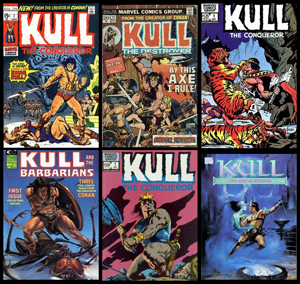 It has been reported that for the first time in 15 months no single comic book gathered more than
It has been reported that for the first time in 15 months no single comic book gathered more than
100,000 copies in orders in the direct sales market. Make that 93,459, to put a
point on it.
Conventional wisdom has it that sales have dropped because the average cover price has gone up, and who am I to question conventional wisdom? But there’s another reason. A big one.
Historically, whenever one of the major publishers (which means Marvel and DC; I’m talking superhero comics here) felt they were being challenged by one or more upstart publishers, that company would flood the market with crap, usually reprints or revivals of frequently cancelled titles. The other publisher would rapidly follow. Before the direct sales tail started wagging the dog, it was believed there was only so much space in the newsstands
and DC and Marvel could crowd the others out. That, of course, was nonsense: if the newsstands cared about comic books (how much profit is there in a 40 cent item?) nobody would have to crowd anybody out.
This philosophy extended to the direct sales market. When companies such as First, Eclipse and Malibu were making waves and racking up competitive sales, DC and Marvel started dumping product into the pipeline. How many times could you revive Kull The Conqueror? But retailers had to order at least a few copies because it was a Marvel Comic, and cumulatively all that sucked a lot of bucks out of retailers’ tills. Remember, they buy this stuff non-returnable.
But now comic book stores have dwindled down to a precious few and the big bookstore chains such as Barnes and Noble and Borders are coughing up blood, sales truly suck.
Which makes it real curious to see that Marvel is once again flooding the comics rack. Having finally lost the Kull license, the House of Idea has gone the Oreo Cookies route: they’re jerking their “going to the movies” properties as though they were crack fiends at a milk farm.
For example: the September Marvel Previews (books on sale November) lists no less than six Iron Man titles, eight Thor titles, and 13 Avengers books. There’s also two event series: Shadowland, which winds up with a mere four titles, and Chaos War, which boasts five.
I didn’t even mention the massive – and expanding – X-Men group. That’s old news.
27 issues featuring Thor, Iron Man, and/or The Avengers.
Boy, you’d think there was a Thor movie coming out that, oh I don’t know, tied in to the Iron Man movies, to be followed by the big The Avengers
movie.
So, why the flood? Is Marvel worried about competition from Boom, Dynamite, and IDW? I don’t think so. They started producing material
for this latest dump just about the time the Disney takeover was ratified. They are trying to impress the Mouse.
Disney doesn’t care about their comic book profits, and nor does Warner Bros. Marvel and DC, respectively, are there as R&D, fodder for movies, television and animation – and their concomitant merchandising revenues. All Marvel and DC have to do on the publishing front is show a decent
return on investment and their new masters will be content.
It’s hard for me to think of a way Marvel could better promote comic book bootlegging.
2010 Harvey Awards Announced!
 The Harvey Awards, named for famed writer/cartoonist Harvey Kurtzman, once again hit the Baltimore Comic Con in style. Emceed by PvP’s esteemed artist and writer Scott Kurtz (not only because his name is close to Harvey’s, but because he’s genuinely funny!), is held in tandem with a celebratory dinner and ceremony. Our intrepid Glenn Hauman was on scene tweeting the winners to us all, and shucks, he even joined the folks for the after-party. We here at ComicMix congratulate all this years nominees and celebrate the victories for this years winners! Did your favorite take home the ole’ Harv’? Find out below!
The Harvey Awards, named for famed writer/cartoonist Harvey Kurtzman, once again hit the Baltimore Comic Con in style. Emceed by PvP’s esteemed artist and writer Scott Kurtz (not only because his name is close to Harvey’s, but because he’s genuinely funny!), is held in tandem with a celebratory dinner and ceremony. Our intrepid Glenn Hauman was on scene tweeting the winners to us all, and shucks, he even joined the folks for the after-party. We here at ComicMix congratulate all this years nominees and celebrate the victories for this years winners! Did your favorite take home the ole’ Harv’? Find out below!
Best Writer:
This years nominees are:
- Jason Aaron, Scalped, Vertigo/DC
- Geoff Johns, Blackest Night, DC
- Robert Kirkman, The Walking Dead, Image Comics
- Jeff Kiney, Diary of a Wimpy Kid #3, Amulet Books
- Mark Waid, Irredeemable, Boom! Studios
And the winner: Robert “Suck it Johns, I PWN Zombies” Kirkman!
He joins other Harvey Winners like Alan Moore, Grant Morrison, Brian K. Vaugn, and Neil Gaiman!
Best Artist:
This years nominees are:
- Robert Crumb, Book of Genesis, W.W. Norton
- Guy Davis, BPRD:Black Goddess, Dark Horse Comics
- Brian Fies, Whatever Happened to the World of Tomorrow, Abrams ComicArts
- David Petersen, Mouse Guard: Winter 1152, Archaia Entertainment
- Frank Quitely, Batman and Robin, DC
- JH Williams III, Detective Comics, DC
And the winner: Robert Crumb!
He joins other Harvey Winners like Dave Gibbons, Alex Ross, Mike Mignola, and Brian Bolland… but c’mon. He’s already had a movie about his life. Gibbons, Ross, Mignola, and Bolland should be proud they now share this award with Robert.
Best Cartoonist:
This years nominees are:
- Darwyn Cooke, Richard Stark’s Parker: The Hunter, IDW
- Jeff Kinney, Diary of a Wimpy Kid #3, Amulet Books
- Roger Langridge, The Muppet Show Comic Book, Boom! Studios
- David Mazzucchelli, Asterios Polyp, Pantheon
- Seth, George Sprott (1894-1975), Drawn and Quarterly
And the winner: Darwyn “Now who do I fight next?” Cooke!
He joins other Harvey Winners like Paul Chadwick, Jeff Smith, Chris Ware, and Sergio Aragones!

